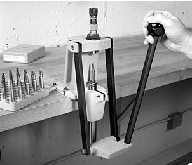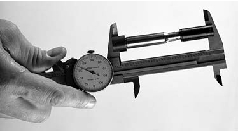Bullet Seating
The charged case is now ready to have a bullet seated into the case mouth. Assuming that the cases have been properly expanded and/or chamfered, bullet seating presents few potential problems. Placing the bullet’s base squarely in the case mouth, guide the bullet into the die body as far as possible to ensure that it does not tip. Ideally, the bullet base should seat snugly in the case mouth, holding itself in alignment. In raising the ram slowly, you will feel the bullet contact the seater plug. Continue raising the ram to fully seat the bullet into the case.
Seating depth for a particular cartridge is determined by a number of factors. In the reloading data section, you will find the seating depth we used for a given bullet in the cartridge in question. Please understand that in most instances this length is only a guide, and that your seating depth may be different.
This is especially true if you are loading for maximum accuracy, and need to adjust the seating depth to match the throat of your particular rifle. This is fine, but bear in mind that deeper seating reduces the capacity of the case, which in turn raises pressures. Going the other way, seating a bullet out to the point that it actually jams into the rifling will also raise pressures. If you vary the seating depth from the length listed in the manual, the charge weights will need to be adjusted accordingly.

A bullet is seated into our primed and charged case. We now have a loaded cartridge!

A Davidson Seating Depth Checker. Also known as comparators, these devices allow the handloader to check the critical relationship of bullet ogive to rifling for a loaded cartridge. This relationship is actually much more important to accuracy than the OAL figure which is more commonly used.
The seating depth for many firearms is determined by the action type, and may not be varied much without causing functioning problems. Autoloading pistols, for example, will be limited to a set maximum length by the magazine. If the rounds are loaded to an OAL that is too short, the pistol may not feed or function reliably. Cartridges that require a crimp, either rifle or handgun, are also limited to a very specific seating depth by cannelure placement on the bullet. Revolvers are a good example of this. Their bullets must be seated to the cannelure so they may properly receive the rollcrimp they need to prevent them from being pulled under recoil.
